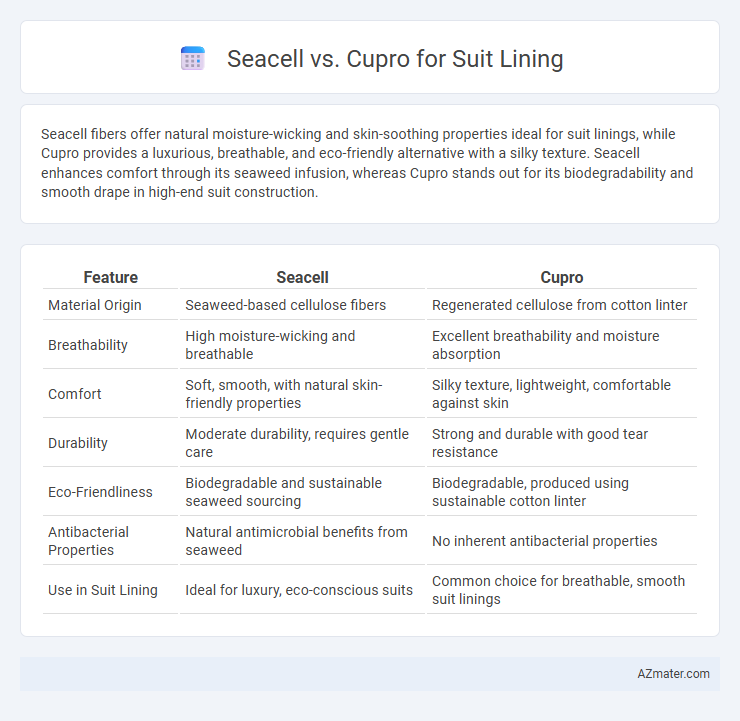Seacell fibers offer natural moisture-wicking and skin-soothing properties ideal for suit linings, while Cupro provides a luxurious, breathable, and eco-friendly alternative with a silky texture. Seacell enhances comfort through its seaweed infusion, whereas Cupro stands out for its biodegradability and smooth drape in high-end suit construction.
Table of Comparison
| Feature | Seacell | Cupro |
|---|---|---|
| Material Origin | Seaweed-based cellulose fibers | Regenerated cellulose from cotton linter |
| Breathability | High moisture-wicking and breathable | Excellent breathability and moisture absorption |
| Comfort | Soft, smooth, with natural skin-friendly properties | Silky texture, lightweight, comfortable against skin |
| Durability | Moderate durability, requires gentle care | Strong and durable with good tear resistance |
| Eco-Friendliness | Biodegradable and sustainable seaweed sourcing | Biodegradable, produced using sustainable cotton linter |
| Antibacterial Properties | Natural antimicrobial benefits from seaweed | No inherent antibacterial properties |
| Use in Suit Lining | Ideal for luxury, eco-conscious suits | Common choice for breathable, smooth suit linings |
Introduction to Innovative Suit Linings
Seacell and Cupro represent innovative materials revolutionizing suit linings with a focus on comfort, breathability, and sustainability. Seacell, derived from seaweed and cellulose, offers natural moisture management and skin-soothing properties, enhancing wearer comfort. Cupro, regenerated from cotton linter, provides a silky texture with excellent breathability and biodegradability, making both materials favored choices in modern eco-conscious tailoring.
What is Seacell? Features & Benefits
Seacell is a sustainable fabric made from cellulose fibers blended with seaweed extracts, offering natural breathability and moisture management ideal for suit linings. This innovative material provides skin-calming benefits, high durability, and enhanced comfort through its biopolymer properties that support temperature regulation and reduce odor. Seacell's eco-friendly production aligns with sustainable fashion trends, making it a superior choice over traditional Cupro linings for performance and environmental impact.
What is Cupro? Features & Benefits
Cupro is a regenerated cellulose fiber derived from cotton linter, known for its silk-like softness and breathability, making it an excellent choice for suit lining. Its natural moisture-absorbing properties help regulate temperature and enhance comfort, while its smooth texture allows suits to drape elegantly. Cupro is biodegradable and hypoallergenic, combining sustainability with luxury and durability in high-quality garment linings.
Seacell vs Cupro: Sustainability Comparison
Seacell and Cupro are both sustainable fabric choices for suit lining, but Seacell stands out due to its eco-friendly production from seaweed and natural fibers, which promotes biodegradability and reduces environmental impact. Cupro, derived from recycled cotton linter, offers a closed-loop production process that minimizes waste and uses fewer chemicals compared to traditional viscose. Sustainability assessments favor Seacell for its renewable raw materials and lower water consumption, while Cupro remains a strong contender for its recycled content and biodegradable properties.
Comfort & Feel: Seacell vs Cupro Linings
Seacell linings offer exceptional moisture-wicking properties and a soft, smooth texture that enhances comfort in suit tailoring. Cupro linings, made from regenerated cotton fibers, provide a silky feel with excellent breathability and temperature regulation. Both materials deliver luxurious comfort, but Seacell excels in antimicrobial benefits while Cupro stands out for its sustainability and silk-like smoothness.
Breathability & Moisture Management
Seacell fabric, derived from seaweed fibers, offers exceptional breathability and natural moisture-wicking properties, making it ideal for suit linings that require comfort in warm conditions. Cupro, a regenerated cellulose fiber made from cotton linter, also provides good breathability but excels in moisture permeability, allowing sweat to evaporate quickly and keeping the wearer dry. While both materials enhance ventilation and moisture management, Seacell's bioactive components add antimicrobial benefits, making it a superior choice for long-lasting freshness in suit linings.
Durability & Care Requirements
Seacell suit linings offer good durability due to their cellulose and seaweed fiber blend, providing natural moisture absorption and antimicrobial benefits that reduce odor and fabric degradation. Cupro suit linings, made from regenerated cotton fibers, boast excellent durability and resilience against wear, with a smooth texture that resists wrinkling and maintains structural integrity after repeated use. Both materials require gentle care; Seacell often needs hand washing or low-temperature delicate cycles to preserve fiber quality, while Cupro can typically be machine washed on a delicate setting but should avoid high heat drying to prevent shrinking or weakening fibers.
Hypoallergenic & Skin-Friendly Properties
Seacell fabric, derived from seaweed fibers, offers exceptional hypoallergenic and skin-friendly properties, making it ideal for suit lining as it helps reduce irritation and soothes sensitive skin. Cupro, a regenerated cellulose fiber from cotton linter, also provides excellent breathability and softness but may not match Seacell's natural antibacterial and anti-inflammatory benefits. Choosing Seacell for suit lining enhances comfort for allergy-prone individuals, while Cupro remains a breathable, smooth alternative with moderate skin sensitivity advantages.
Style, Finish, and Aesthetic Appeal
Seacell offers a smooth, silky finish with natural moisture-wicking and antibacterial properties, making it ideal for stylish, breathable suit linings that maintain comfort and freshness. Cupro provides a luxurious sheen and soft texture resembling silk, enhancing the suit's overall aesthetic appeal with a subtle drape and excellent durability. Both materials elevate style, but Seacell emphasizes eco-friendly performance, while Cupro focuses on classic elegance and refined finish.
Which Lining is Best for Suits? Seacell or Cupro?
Seacell and Cupro are popular choices for suit linings, each offering distinct benefits: Seacell is an eco-friendly fiber derived from seaweed, providing natural moisture-wicking and anti-odor properties, which enhance comfort during extended wear. Cupro, a regenerated cellulose fiber made from cotton linter, is known for its silky smooth texture, breathability, and excellent draping qualities, making it ideal for high-end and luxury suits. Choosing the best lining between Seacell and Cupro depends on priorities such as sustainability and skin benefits (Seacell) versus traditional smooth feel and superior breathability (Cupro), with many premium suits favoring Cupro for its luxurious finish.

Infographic: Seacell vs Cupro for Suit Lining
 azmater.com
azmater.com